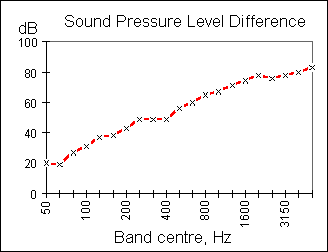

Part 3: Sound Isolation
To a first approximation, interfering sound needs to be reduced to below the level of the ventilation noise, to be no longer a nuisance. So you can calculate the sound isolation (or insulation) needed between a location with interfering noise, and a studio. Simply:
Maximum level of interfering noise
minus ventilation noise level in studio
equals required sound insulation
This calculation needs to be done on the spectrum, in 1/3 octave frequency bands. The word "maximum" may need a bit of thought - it may not be cost-effective to design a studio to keep out high sound levels that will occur only very occasionally.
All normal wall materials give a sound isolation performance that shows a general trend of increasing with frequency, so graphs of sound isolation look rather like this:

The vertical axis shows the sound pressure level difference in decibels, so the higher the better. A figure of 50 dB means that a sound level of, say, 80 dB in the source room (in the relevant frequency band) would be reduced to 30 dB in the receiving room.
Measures of sound isolation
A graph such as the one above gives very useful information. However for specifications, sound isolation is often boiled down to a single figure. (This is not ideal when low frequency performance is important, as the standard single- figure measures do not cover low frequencies.)
Unfortunately most quantities in acoustics are in decibels, and this causes confusion. (If all electrical quantities were specified in decibels, you would still want to distinguish between watts, volts and amps!) You may come across several measures for sound isolation (all in decibels of course):
-
STC (US) or Rw (Europe). The performance of a material or product (for example, a wall structure or door) as measured under standard conditions. These measures allows different products to be compared without having to take account of the conditions of use. There is a tendency to quote STC - could it be because the STC is usually about a decibel better than the Rw?
-
NIC (US) or Dw (Europe). This is the result, or predicted result, of a measurement on a pair of real rooms. It is getting nearer to what you would really like to know: if there is noise at a level of 100 dB next door, what will be the sound level in my studio?
(These single-figure measures are calculated from the 1/3 octave results in a somewhat roundabout way, which it's beyond the scope of this guide to explain. For the European measurements you might also see added "+ Ctr". This takes more account of low frequency noise; but of course it must be compared with other data measured the same way.)
One of the most common elementary mistakes in building acoustics is to get lab measured product data confused with room measurements or predictions. For sound passing through a partition between two adjacent rooms, the isolation obviously depends on what the partition is made of - which is where the laboratory measured figures of STC etc. come in. However it also depends very much on factors that vary between different rooms and layouts:
-
The area of the partition. The more square metres, the more sound will get through! You can sometimes get away with a relatively low Rw or STC for doors, because the area of a door is normally much less than that of the wall it's set in.
-
The amount of sound absorbent material in the "receive" room. The more absorbent material in the receiving room, the lower the sound level there (other things being equal), so the better the isolation.
So if you have to compare, make sure you're comparing like with like.
Flanking sound transmission
Apart from what comes directly than through the dividing partition, sound will come via other routes - for example, via the common floor, ceiling, and side walls that will all vibrate in response to the sound. This is called "flanking" sound transmission. Laboratory tests are carefully designed to exclude this, so simple calculation based on the properties of the main partition wall materials will nearly always give a very optimistic prediction of sound insulation. The ventilation system also has to be designed so that it does not transfer sound between rooms.
Of course good sound-isolating walls are essential. But once you have these, flanking transmission will probably affect sound isolation as much as, or even more than, what comes through the partition wall itself. This so important that the design of studio structures is largely aimed at reducing flanking transmission to the minimum. The usual way to do this is "fully floating" - a box supported on springs, and otherwise isolated from the surrounding structure as far as possible.
Unlike background noise and reverberation time, it is very difficult to give typical values for sound isolation of studios, as the required isolation depends so much on the level of the noise that has to be kept out, or in.
To give an idea, a minimum specification for insulation between two speech studios, or DJ studios where music will not be played loudly, might be Dw = 55 dB.
Doors and windows
The sound isolation given by a door (or an openable window) depends critically on the performance of the seals. It is reasonable to assume that when the laboratory tests were done, the manufacturer made sure that the seals were in perfect condition and adjusted as well as possible. It is also reasonable to assume that when doors are installed in your studio and have been in use for a while, the seals may not work quite so perfectly. So the experience of the designer in choosing doors and seals that will continue to work well over a period of time, is important.
For doors that are sold without seals, the lab tests may even have been done with the gaps completely filled with sealant - which does wonders for the sound insulation, even if it makes the door impossible to open. Caveat emptor! A good consultant will know,not just what the figures are, but what they really mean. Continue
Phone or email for a free initial discussion about your project.
Phone 020 7624 2512 or click to contact us.
Text charts and images copyright Tony Woolf 2000 unless otherwise stated.




